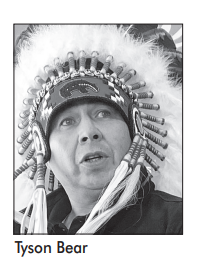
Recently, chief Tyson Bear of Flying Dust First Nation and Rebecca Alty, federal minister of Crown-Indigenous relations, announced a settlement agreement to resolve a land-related claim between Canada and the First Nation. Canada will provide more than $55 million in compensation to the Flying Dust First Nation for the improper transfer of 214.81 acres of treaty land in 1932 to the Canadian Pacific Railway which denied the First Nation its use for generations. Since then, about 200.8 acres have been returned, including two pieces of land held by Canada for the local Royal Canadian Mounted Police (RCMP) detachment. The RCMP and the First Nation signed a lease, and, on Nov. 7, 2024, the land was formally transferred back to reserve status. The remaining land, once owned by the railway company, was remediated through cooperation between Canada, the Canadian National Railway (successor to the Canadian Pacific Railway) and the community.
“This settlement is a step toward reconciliation,” Bear said. “A good example of Canada righting the wrongs made so many years ago, proving this government is moving in the right direction in true nation-tonation relationship building. The railway claim settlement opens the doors for Flying Dust and paves the way for economic prosperity and ensures the financial well-being of Flying Dust and generations to come.” This was echoed by Alty. “In order to build a better, more equitable future, we need to work together,” she said. “The resolution of this claim marks a meaningful step forward in Canada’s relationship with the people of Flying Dust First Nation. This long-overdue compensation recognizes past wrongs and supports the nation’s efforts to create lasting opportunities for future generations.” As part of the agreement, the First Nation may also add nearly 14 acres to its reserve through Canada’s Additions to Reserve process.
Flying Dust First Nation has always recognized the railway lands as reserve land. The story of how it was expropriated in the early 1930s is part of the oral history of leadership. The story of the land has been passed down the years to ensure the people didn’t forget. From chief to chief, from council to council, Flying Dust First Nation always committed to have the railway lands returned home. A plan was made in 1992 when chief Richard Gladue placed a caveat on the lands and launched the lawsuit. In the 30 years that followed, every chief and council joined the team and pushed the file forward. The most recent leadership team, chief Tyson Bear and councillors Calvin Bear, Marie Gladue, Nick Derocher and Charmaine Mirasty were the ones who got to see the claim to its fruition. The vision of reacquiring the railway lands has always been seen as a certainty. As such, plans for development of the property has been ongoing for almost 20 years. Flying Dust has always had a vision of what the land could be and what it would mean for the people of Flying Dust, Meadow Lake and the surrounding communities.
Settlements like this provide funding First Nations can use to buy land and create new opportunities for their communities and economies. Settling specific claims is one way Canada is working to rebuild trust and strengthen its relationships with First Nations. By providing fair compensation when promises haven’t been kept, Canada is taking responsibility for the past and working toward a more respectful future. These efforts are guided by the United Nations Declaration on the Rights of Indigenous Peoples Act. Among those also pleased with the settlement agreement is Desnethé-MissinippiChurchill River MP Buckley Belanger.
“This long overdue settlement is about respect, recognition and reconciliation, and about building a renewed partnership between Flying Dust First Nation and Canada,” Belanger, who serves as the Liberal government’s secretary of state for rural development, noted. “Flying Dust First Nation never stopped fighting to see this land returned, and I want to congratulate chief Tyson Bear and his community for their perseverance and leadership in addressing this historic wrong.” With 2,674 members (646 living on-reserve and 2,028 living off-reserve) Flying Dust First Nation has developed a reputation as a strong, progressive community.